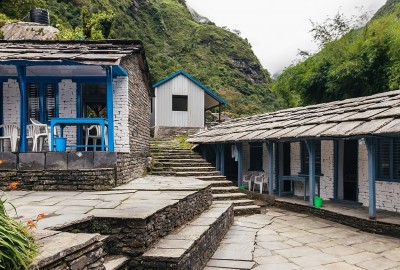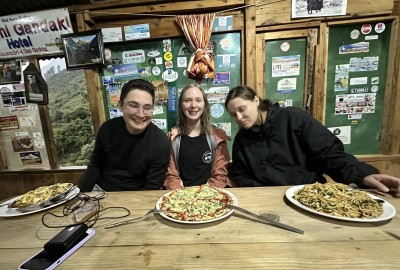The Kathmandu Valley is a living museum of cultural heritage, where ancient traditions pulse through the rhythm of daily life. Throughout the year, the valley comes alive with vibrant festivals that reflect its rich tapestry of Hindu and Buddhist traditions. These celebrations, following the lunar calendar, mark agricultural cycles, honor deities, and strengthen community bonds. Let's journey through a year of festivities in this sacred valley.
Table of Contents
Plan your trip to Nepal
Customize your trip with help from a local travel specialist.
Magh (January-February)
Maghe Sankranti (1st day of Magh)
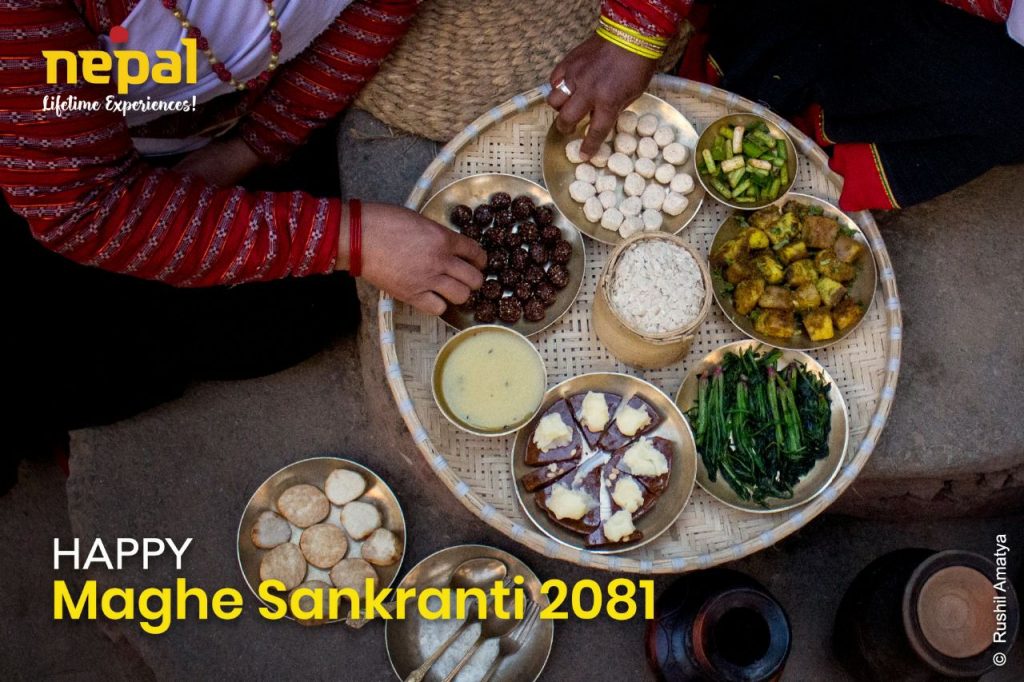
Image Source: Nepal Tourism Board
Maghe Sankranti also known as Makar Sankrati marks the transition of the sun into Capricorn and signals the end of winter's harshest days. This auspicious day is considered the beginning of the holy month of Magh. Devotees wake before dawn to bathe in sacred rivers, particularly at the confluence of the Bagmati and Bishnumati rivers. The ritual bath is believed to cleanse sins and bring spiritual merit.
Families gather to prepare special dishes made from sesame seeds, molasses, and ghee—ingredients that provide warmth and energy during the cold season. Til ko laddu (sesame seed balls) and chaku (hardened molasses) are traditional favorites. Many people also visit temples to offer prayers and make charitable donations, believing that good deeds performed during Magh carry extra spiritual weight.
Phaagun (February-March)
Losar (1st day of Tibetan New Year, varies by lunar calendar)

Image Source: Nepal Tourism Board
Losar, the Tibetan New Year, is celebrated with great enthusiasm by the Sherpa, Tamang, and other Buddhist communities in the Kathmandu Valley. The festival typically lasts for fifteen days, with the first three days being the most significant.
Homes are thoroughly cleaned and decorated with colorful prayer flags. Families prepare special foods like khapse (deep-fried pastries), guthuk (noodle soup), and chang (traditional beer). On New Year's Eve, people gather to eat guthuk, which contains dumplings with different fillings—each symbolizing predictions for the coming year.
The first day of Losar begins with visits to monasteries, where monks perform special prayers and rituals. People dress in traditional attire, exchange greetings of "Tashi Delek," and visit friends and relatives. The air fills with the aroma of juniper incense and the sound of traditional instruments.
Holi (Phaagun Purnima - Full Moon of Phaagun)

Image Source: Nepal Tourism Board
Holi, the exuberant festival of colors, transforms the Kathmandu Valley into a vibrant canvas of joy and celebration. This spring festival celebrates the victory of good over evil, the arrival of spring, and the end of winter's gloom.
The festivities begin on the evening before Holi with Holika Dahan, where bonfires are lit to commemorate the burning of the demoness Holika. People gather around the fire, performing prayers and circumambulating it, symbolizing the destruction of evil.
The main day of Holi is a spectacular explosion of colors. People of all ages take to the streets armed with colored powders (abir) and water-filled balloons. The usual social boundaries dissolve as everyone—young and old, rich and poor—becomes equal participants in this colorful chaos. Strangers greet each other with "Holi Hai!" while smearing colors on faces and clothes.
In Basantapur Durbar Square and traditional Newar neighborhoods, the celebration takes on unique cultural dimensions. Groups play traditional instruments, sing folk songs, and perform dances. Special delicacies like gujiya (sweet dumplings) and thandai are prepared and shared among friends and family.
The festival embodies the spirit of forgiveness, renewal, and the breaking down of social barriers. By the end of the day, the entire valley appears painted in a rainbow of hues, with everyone bearing colorful evidence of their participation in this joyous celebration.
Maha Shivaratri (Phaagun Krishna Chaturdashi - 14th day of waning moon)

Maha Shivaratri, the "Great Night of Shiva," is one of the most important festivals for Hindu devotees in the Kathmandu Valley. Pashupatinath Temple becomes the epicenter of celebrations, attracting hundreds of thousands of pilgrims from Nepal and India.
Devotees observe a strict fast and stay awake through the night, chanting prayers and mantras dedicated to Lord Shiva. The temple complex transforms into a sea of humanity, with sadhus (holy men) performing rituals, smoking cannabis (considered sacred to Shiva), and meditating. Devotees offer bel leaves, milk, honey, and water to the Shiva lingam, symbolizing purification and devotion.
The night resonates with the sound of temple bells, devotional songs, and the chanting of "Om Namah Shivaya." Many believe that sincere worship on this night can liberate one from sins and lead to moksha (spiritual liberation).
Chaitra (March-April)
Balaju Jatra (Chaitra Shukla Ashtami - 8th day of waxing moon)

Image Source: Online Khabar
Balaju Jatra is a unique local festival centered around Balaju's ancient water garden, featuring 22 stone spouts carved in the shape of animal heads. This festival holds special significance for those seeking blessings for health and prosperity.
Devotees, particularly from the Newar community, gather to perform rituals at the water spouts and the Balaju Shiva temple. The festival involves bathing in the sacred waters, believed to possess healing properties. Special pujas are conducted, and the atmosphere is filled with devotional fervor as families picnic in the garden area, combining spiritual practice with community bonding.
Baisakh (April-May)
Bisket Jatra (From Baisakh 1 - Nepali New Year)

Image Source: Nepal Tourism Board
Bisket Jatra, celebrated primarily in Bhaktapur, is one of the most dramatic festivals in the Kathmandu Valley, marking the Nepali New Year. The week-long festival features a spectacular chariot procession and a unique tug-of-war competition.
Massive wooden chariots carrying the images of deities Bhairab and Bhadrakali are pulled through Bhaktapur's narrow streets by competing groups of devotees. The atmosphere is electric with excitement and sometimes even friendly rivalry. On New Year's Eve, a ceremonial pole (yosin) with two banners representing serpents is erected at Khalna Tole. At midnight, when the pole crashes down, the new year officially begins amid thunderous cheers.
The festival also includes sindoor (vermillion powder) throwing, creating a sea of red that symbolizes victory over evil. The energy, devotion, and sheer spectacle make Bisket Jatra an unforgettable experience.
Buddha Jayanti (Baisakh Purnima - Full Moon of Baisakh)

Image Source: Nepal Tourism Board
Buddha Jayanti commemorates the birth, enlightenment, and death (parinirvana) of Lord Buddha—all believed to have occurred on the same day of the full moon in Baisakh. This international Buddhist festival holds profound significance in the Kathmandu Valley, home to some of the world's most sacred Buddhist sites.
Swayambhunath (the Monkey Temple) and Boudhanath Stupa become focal points of celebration. These ancient stupas are adorned with prayer flags, butter lamps, and flowers. Thousands of devotees circumambulate the stupas, spin prayer wheels, and offer prayers throughout the day and night.
Monasteries organize special prayer ceremonies, and monks conduct elaborate rituals. The atmosphere is one of peace and reflection, with devotees observing the Five Precepts more strictly and engaging in acts of compassion and charity. Many people also visit Lumbini, Buddha's birthplace in southern Nepal, to pay homage.
Asaar (June-July)
Ropain (Throughout Asaar - Rice Planting Season)

Image Source: Nepal Tourism Board
Ropain celebrates the beginning of the rice planting season, reflecting the valley's deep agricultural roots. Though urbanization has diminished farming in many areas, this festival remains culturally significant.
Traditional mud-plastered homes are freshly painted, and farmers prepare their fields for planting. Communities gather for collective rice planting, turning hard labor into a joyful social event. People sing traditional ropain songs, with rhythmic melodies that make the work lighter and more enjoyable.
Special rice-based dishes and yogurt are prepared. In some areas, mock rice planting ceremonies are held to keep the tradition alive, especially for younger generations who may have never worked in paddy fields. The festival embodies gratitude for water, earth, and the sustenance they provide.
Saaun (July-August)
Janai Purnima (Saaun Purnima - Full Moon of Saaun)

Image Source: Janai Purnima
Janai Purnima is a significant Hindu festival when Brahmin men change their sacred thread (janai) and people tie protective threads (doro) around their wrists. The festival also celebrates Raksha Bandhan, honoring the brother-sister bond.
Gosaikunda Lake in the mountains becomes a major pilgrimage destination, with thousands of devotees making the arduous trek. In the valley, people visit temples, especially Kumbheshwar Temple in Patan, where a special ritual bath is taken in the sacred tank believed to be connected to Gosaikunda through underground channels.
Shamans and priests tie blessed yellow and red threads around people's wrists for protection against evil and misfortune. Sisters tie rakhi threads on their brothers' wrists, and brothers give gifts in return, pledging to protect their sisters. The day is marked by special feasts and family gatherings.
Bhadra (August-September)
Krishna Janmashtami (Bhadra Krishna Ashtami - 8th day of waning moon)

Image Source: Nepal Tourism Board
Krishna Janmashtami celebrates the birth of Lord Krishna, one of Hinduism's most beloved deities. The festival is observed with particular devotion at Krishna Mandir in Patan, an architectural masterpiece dedicated to Krishna.
Devotees fast throughout the day and break their fast only at midnight—the believed time of Krishna's birth. Temples are beautifully decorated with flowers and lights. Devotional songs (bhajans) fill the air, recounting Krishna's childhood pranks and divine exploits.
Dahi handi, a tradition where young men form human pyramids to break a pot filled with yogurt suspended high above the ground, adds an element of excitement. This recreates Krishna's legendary butter-stealing adventures. The festival emphasizes love, devotion, and the playful aspects of spirituality.
Gokarna Aunsi (Bhadra Krishna Aunsi - New Moon of Bhadra)

Image Source: Nepal Tourism Board
Gokarna Aunsi, Nepal's Fathers' Day, is observed on the new moon day of Bhadra. People honor their fathers, and those whose fathers have passed away perform special rituals for their souls at Gokarna, a sacred site near the Bagmati River.
The day begins with ritual baths in the Bagmati River at Gokarna. Families offer pinda (rice balls) and sesame seeds to departed fathers, performed by priests amid the chanting of mantras. Living fathers are honored with new clothes, delicious food, and tokens of respect.
The atmosphere at Gokarna is both solemn and celebratory—a beautiful blend of mourning and gratitude. The festival reinforces the importance of parental respect and familial bonds in Nepali culture.
Teej (Bhadra Shukla Teej - 3rd day of waxing moon)

Image Source: Nepal Tourism Board
Teej is a vibrant festival celebrated primarily by women, honoring Goddess Parvati and praying for marital bliss and family well-being. The three-day festival is marked by red saris, dancing, singing, and fasting.
On the eve of Teej (Dar Khane Din), women gather for lavish feasts before their fast. The main day involves a strict fast without food or water, which married women observe for their husbands' longevity and unmarried women observe to pray for good husbands.
Women dress in their finest red and green attire, adorned with jewelry and red bangles, and visit Pashupatinath Temple. The journey becomes a procession of song and dance, with streets transformed into rivers of red. Traditional folk songs resonate through the valley as women dance in circles, celebrating feminine strength and devotion.
The third day (Rishi Panchami) involves ritual purification baths and worship of Sapta Rishi (Seven Sages), symbolizing respect for wisdom and spiritual guidance.
Ashoj (September-October)
Dashain (15 days, culminating on Ashoj Shukla Dashami - 10th day of waxing moon)

Image Source: Nepal Tourism Board
Dashain, the longest and most important festival in Nepal, celebrates the victory of good over evil. The fifteen-day festival honors Goddess Durga's triumph over the demon Mahishasura and Lord Rama's victory over Ravana.
The festival begins with Ghatasthapana, when a sacred vessel filled with holy water and jamara (sprouted barley seedlings) is established in homes. The ninth day (Maha Nawami) involves the sacrifice of animals at temples and homes, offering blood to appease the goddess.
The tenth day (Vijaya Dashami) is the most significant. Elders place tika (a mixture of rice, yogurt, and vermillion) and jamara on the foreheads of younger family members, blessing them with prosperity and longevity. This ritual of receiving tika from elders continues for several days.
People wear new clothes, families reunite from across the country and abroad, and the air fills with festive joy. Flying kites, playing on bamboo swings, and feasting on special foods like sel roti, meat curry, and sweets are integral parts of the celebration. Dashain embodies family bonds, cultural continuity, and spiritual renewal.
Kartik (October-November)
Tihar (5 days, from Kartik Krishna Trayodashi to Kartik Shukla Dwitiya)

Image Source: Nepal Tourism Board
Tihar, also known as the festival of lights, is a five-day celebration honoring different animals and relationships. Each day has special significance, making it one of the most colorful festivals in Nepal.
The first day honors crows (messengers of death), the second day honors dogs (guardians and loyal companions), and the third day celebrates Goddess Lakshmi with the lighting of countless oil lamps and candles. Homes are cleaned, decorated with intricate rangoli patterns, and illuminated, transforming the valley into a glittering wonderland.
The fourth day has multiple traditions: honoring oxen (in Newar communities) and celebrating Govardhan Puja and the new year of the Nepal Sambat calendar. The fifth day is Bhai Tika, when sisters place elaborate multi-colored tika on their brothers' foreheads, praying for their long life, while brothers offer gifts and promise protection.
Groups of girls go door-to-door singing Bhailo songs, while boys sing Deusi, receiving money and food in return. The festival creates a magical atmosphere of light, music, and familial love.
Chhath (4 days, on Kartik Shukla Shashthi - 6th day of waxing moon)
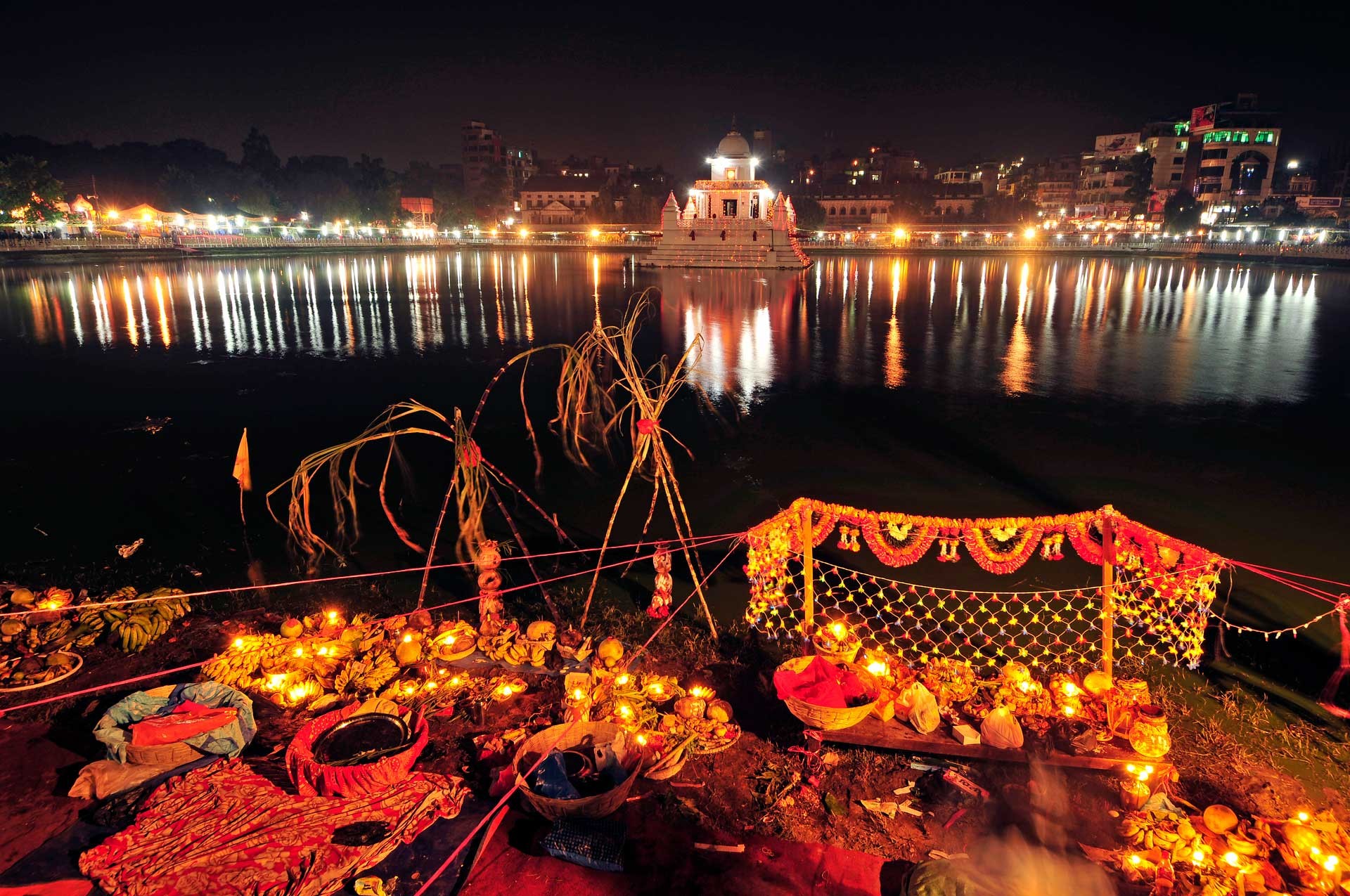
Image Source: Nepal Tourism Board
Chhath is an ancient Vedic festival dedicated to Surya (the Sun God) and Chhathi Maiya (Goddess Usha). Primarily celebrated by the Madhesi and Tharu communities from the Terai region now living in Kathmandu, it has become a significant valley festival.
The four-day festival involves rigorous fasting and ritual purity. Devotees, especially women, abstain from food and water for long periods. They prepare special offerings and gather at ghats (riverbanks) and ponds—particularly Guheshwari, Kamal Pokhari, and the Bagmati River.
The most striking ritual occurs at sunset and sunrise when devotees stand waist-deep in water, offering prayers and arghya (offerings) to the setting and rising sun. The sight of hundreds of devotees in traditional attire, holding offering baskets filled with fruits, thekua (special cookies), and diyas (oil lamps), is profoundly moving.
Chhath emphasizes gratitude for life's fundamental elements—sun, water, and air—and showcases the valley's cultural diversity.
Mangsir (November-December)
Indrayani Jatra (Varies by location, typically mid-Mangsir)
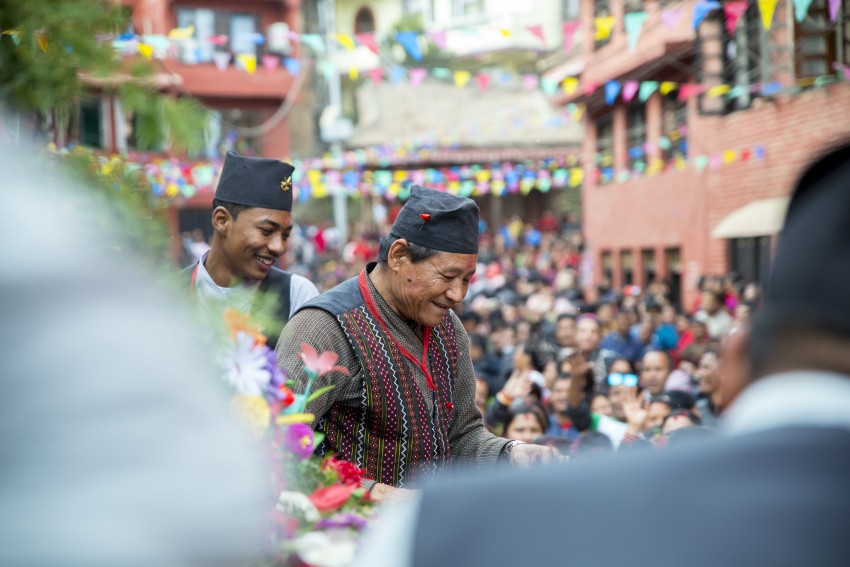
Image Source: Nepal Tourism Board
Indrayani Jatra is a unique local festival celebrated in various parts of the Kathmandu Valley, particularly in areas with Indrayani temples. The festival honors Goddess Indrayani, an incarnation of Goddess Durga.
Devotees, particularly from the farming community, gather to offer thanks for the harvest and seek blessings for prosperity. The festival includes traditional mask dances, musical performances, and processions. In Kirtipur and other areas, elaborate rituals are performed at Indrayani temples with animal sacrifices and community feasts.
The festival maintains strong local character, varying in customs across different neighborhoods, reflecting the valley's micro-cultural diversity.
Bala Chaturdashi (Mangsir Krishna Chaturdashi - 14th day of waning moon)
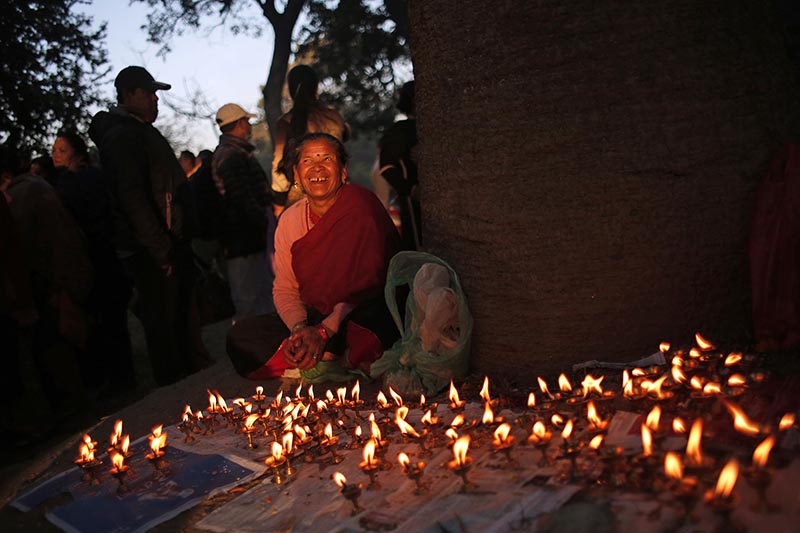
Image Source: The Himalayan Times
Bala Chaturdashi is a solemn festival observed at Pashupatinath Temple to honor deceased family members. According to belief, souls who died untimely deaths wander as animals in the Shleshmantak forest near Pashupatinath.
Devotees spend the night at Pashupatinath, staying awake in vigil. At dawn, they scatter seven types of grains (Satbij) along a prescribed path through the forest while reciting prayers. This ritual is believed to help liberate the wandering souls and provide them peace.
Thousands of oil lamps illuminate the temple complex throughout the night, creating a serene and spiritual atmosphere. Families gather to remember their departed loved ones, performing rituals and making offerings. The festival emphasizes compassion for all souls and the continuation of bonds beyond death.
Conclusion
The festivals of Kathmandu Valley are not mere celebrations—they are the heartbeat of a living culture. Each festival carries centuries of tradition, weaving together mythology, agriculture, family bonds, and spiritual practice. From the thunderous chariots of Bisket Jatra to the serene lamp-lit nights of Tihar, from the devotional fervor of Shivaratri to the joyous songs of Teej, these celebrations reflect the valley's soul.
In an era of rapid modernization, these festivals serve as anchors to identity and community. They bring together people across generations, reminding them of shared values and heritage. For visitors, they offer windows into a culture where the sacred and secular dance together, where ancient traditions adapt yet endure, and where every month brings new reasons to celebrate life.
In recent years, these festivals have become increasingly attractive to tourists from around the world. The Kathmandu Valley has transformed into a vibrant cultural destination where international visitors don't just observe—they actively participate in the celebrations. During Holi, tourists gleefully join locals in the colorful chaos, getting drenched in vibrant powders. At Tihar, foreign visitors help light diyas and create rangoli patterns alongside Nepali families. The mesmerizing atmosphere of Shivaratri at Pashupatinath draws thousands of international spiritual seekers and photographers.
The valley's festivals offer something rare in today's world: authentic cultural immersion. Unlike staged performances, these are living traditions where tourists can experience genuine hospitality, taste traditional foods prepared for the occasion, learn folk dances, and understand the deeper spiritual meanings behind rituals. Many visitors time their Nepal trips specifically around major festivals like Dashain, Tihar, or Bisket Jatra, recognizing these as once-in-a-lifetime experiences.
Local communities have embraced this cultural exchange with warmth and openness. It's common to see tourists being invited into homes for tika during Dashain, participating in community dances during Teej, or joining families for festive meals. This interaction benefits both visitors and locals—tourists gain profound cultural insights while locals take pride in sharing their heritage with the world. The economic boost from festival tourism also helps preserve these traditions, as communities invest in maintaining temples, organizing processions, and keeping customs alive for future generations.
Whether you're a resident or a visitor, experiencing these festivals in the Kathmandu Valley is to witness humanity's eternal dance with the divine—colorful, chaotic, deeply moving, and utterly unforgettable. For tourists, it's an opportunity not just to see Nepal, but to feel its heartbeat and become part of its story, even if just for a moment.

.png)
